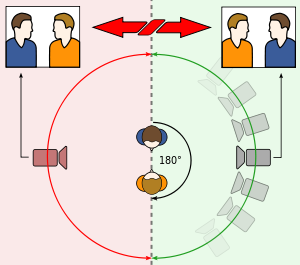180 degree rule
From Wikipedia, the free encyclopedia
The 180° rule is a basic guideline in film making that states that two characters (or other elements) in the same scene should always have the same left/right relationship to each other. If the camera passes over the imaginary axis connecting the two subjects, it is called crossing the line. The new shot, from the opposite side, is known as a reverse angle.
Contents |
[edit] Examples
In the example of a dialogue, if Owen (Orange shirt in the diagram) is on the left and Bob (Blue shirt) is on the right, then Owen should be facing right at all times, even when Bob is off the edge of the frame, and Bob should always be facing left. Shifting to the other side of the characters on a cut, so that Bob is now on the left side and Owen is on the right, will disorient the viewer, and break the flow of the scene.
In the example of an action scene, such as a car chase, if a vehicle leaves the right side of the frame in one shot, it should enter from the left side of the frame in the next shot. Leaving from the right and entering from the right will create a similar sense of disorientation as in the dialogue example.
An excellent example of sustained use of the 180 degree rule occurs throughout much of The Big Parade, a drama about World War One directed by King Vidor. In the sequences leading up to the battle scenes, the American forces (arriving from the west) are always shown marching from left to right across the screen, while the German troops (arriving from the east) are always shown marching from right to left. After the battle scenes, when the weary troops are staggering homeward, the Americans are always shown crossing the screen from right to left (moving west) and the Germans from left to right (moving east). The audience's viewpoint is therefore always from a consistent position, in this case southward of the action.
[edit] Problems caused and solutions
Avoiding crossing the line is a problem that those learning filmcraft will need to struggle with. In the above example with the car chase, a possible solution is to begin the second cut with the car driving into frame from the "wrong" side. Although this may be wrong in the geographic sense on set, it looks more natural to the viewer. Another possibility is to insert a "buffer shot" of the subject head-on (or from behind) to help the viewer understand the camera movement [1].
[edit] Style
In professional productions, the applied 180° rule is an essential element for a style of film editing called continuity editing. The rule is not always obeyed. Sometimes a filmmaker will purposely break the line of action in order to create disorientation. Stanley Kubrick was known to do this. The Wachowski Brothers and directors Tinto Brass, Yasujiro Ozu, Wong Kar-Wai and Jacques Tati sometimes ignored this rule also.[2] The British TV presenters Ant & Dec extend this continuity to almost all their appearances, with Ant almost always on the left and Dec on the right.
Some filmmakers state that the fictional axis created by this rule can be used to plan the emotional strength of a scene. The closer you place the camera to the axis, the more emotionally involved the audience will be.
In the Japanese animated picture Paprika, two of the main characters discuss crossing the line and demonstrate the disorienting effect of actually performing the action.
[edit] See also
[edit] External links
- VIDEO on 180 degree rule
- Animated examples of the 180 Degree rule
- Some excerpts on the 30 Degree rule as well.
- Spanish shortfilm mocking the 180 degree rule.
|
|||||


